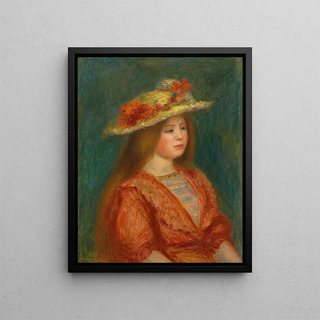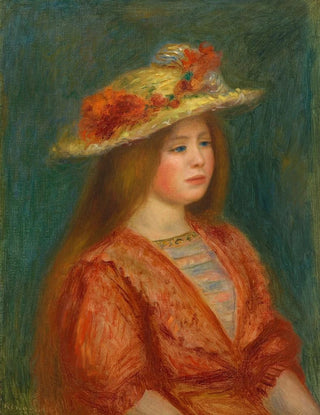Art print | Woman with Red Corsage - Pierre-Auguste Renoir


View from behind

Frame (optional)
Pierre-Auguste Renoir's "Woman with a Red Corsage" stands as a tribute to feminine beauty and the delicacy of emotions. Painted in 1876, this canvas embodies the very essence of Impressionism, an artistic movement that masterfully captured light and life in all their splendor. The viewer's gaze is immediately drawn to the central figure, a woman dressed in a vibrant red corsage, radiating warmth and an almost palpable vitality. This artwork does more than depict a woman; it invites a sensory exploration, where each brushstroke tells a story and every shade of color evokes an emotion.
Style and uniqueness of the work
In "Woman with a Red Corsage," Renoir employs a palette of vivid colors, where the red of the corsage harmoniously contrasts with the softer hues of the background. This bold use of color is one of the artist's signature traits, showcasing his skill in playing with light and shadow to bring his subjects to life. The composition, both simple and intricate, creates an intimate, almost confidential atmosphere, where one can almost hear the whisper of the woman's thoughts. The details are rendered with a lightness that gives the piece a sense of movement, as if the figure could come alive at any moment. This Impressionist approach, favoring the fleeting impression of a moment over academic precision, makes this work a key piece in art history.
The artist and his influence
Pierre-Auguste Renoir, an emblematic figure of Impressionism, left a lasting mark on his era with his unique style and artistic vision. Born in 1841, he initially worked in decorative workshops before dedicating himself entirely to painting. Renoir was passionate about depicting everyday life, scenes of joy and conviviality. His influence extends far beyond his time, inspiring many contemporary and later artists. Through works such as "Woman with a Red Corsage," he transcended the artistic conventions of his period, paving the way for a new way of seeing and feeling art.

Matte finish

View from behind

Frame (optional)
Pierre-Auguste Renoir's "Woman with a Red Corsage" stands as a tribute to feminine beauty and the delicacy of emotions. Painted in 1876, this canvas embodies the very essence of Impressionism, an artistic movement that masterfully captured light and life in all their splendor. The viewer's gaze is immediately drawn to the central figure, a woman dressed in a vibrant red corsage, radiating warmth and an almost palpable vitality. This artwork does more than depict a woman; it invites a sensory exploration, where each brushstroke tells a story and every shade of color evokes an emotion.
Style and uniqueness of the work
In "Woman with a Red Corsage," Renoir employs a palette of vivid colors, where the red of the corsage harmoniously contrasts with the softer hues of the background. This bold use of color is one of the artist's signature traits, showcasing his skill in playing with light and shadow to bring his subjects to life. The composition, both simple and intricate, creates an intimate, almost confidential atmosphere, where one can almost hear the whisper of the woman's thoughts. The details are rendered with a lightness that gives the piece a sense of movement, as if the figure could come alive at any moment. This Impressionist approach, favoring the fleeting impression of a moment over academic precision, makes this work a key piece in art history.
The artist and his influence
Pierre-Auguste Renoir, an emblematic figure of Impressionism, left a lasting mark on his era with his unique style and artistic vision. Born in 1841, he initially worked in decorative workshops before dedicating himself entirely to painting. Renoir was passionate about depicting everyday life, scenes of joy and conviviality. His influence extends far beyond his time, inspiring many contemporary and later artists. Through works such as "Woman with a Red Corsage," he transcended the artistic conventions of his period, paving the way for a new way of seeing and feeling art.






